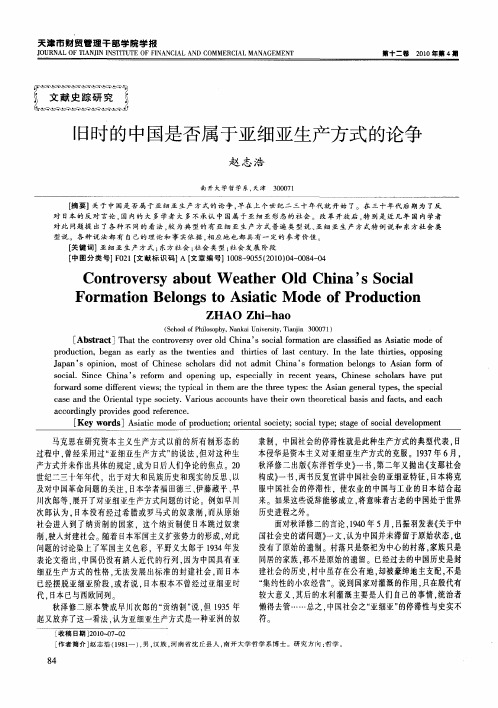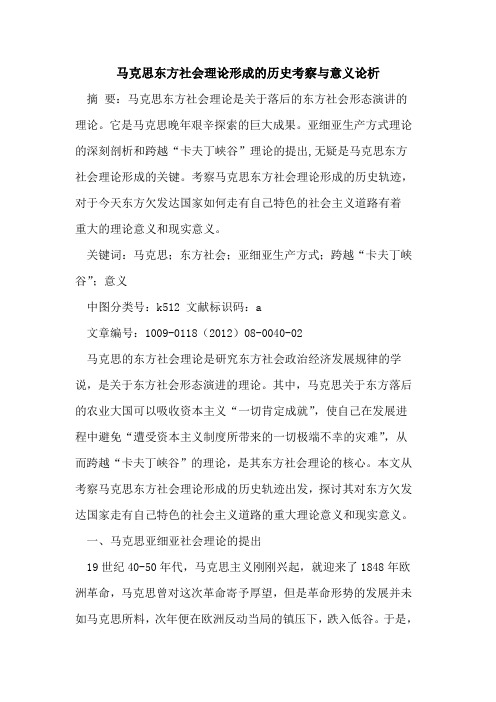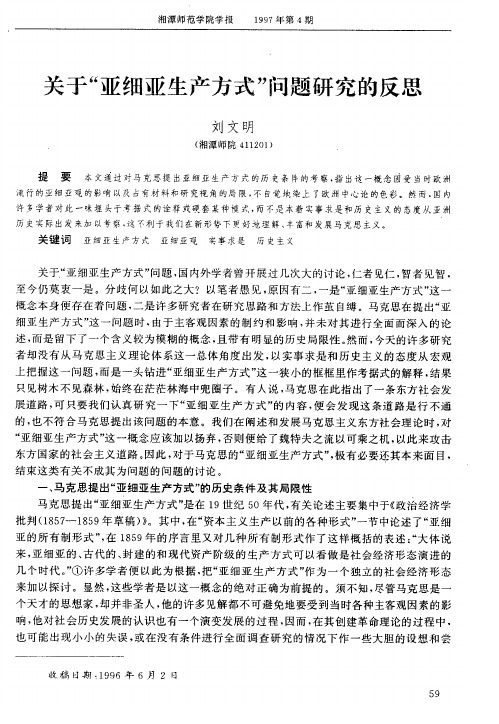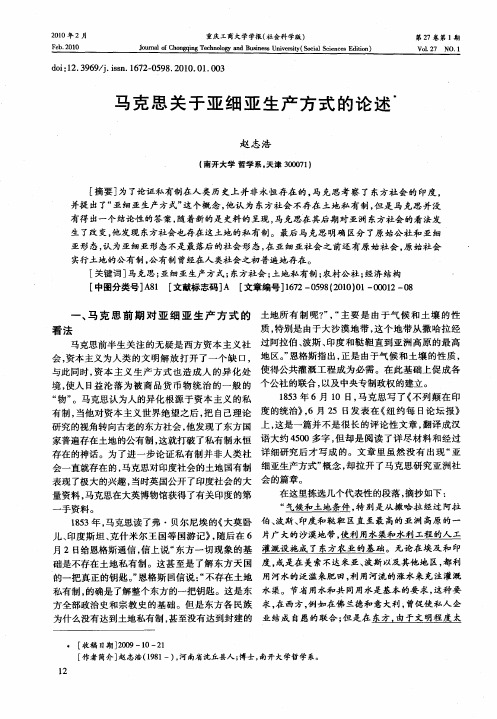亚细亚生产方式理论
- 格式:ppt
- 大小:556.50 KB
- 文档页数:13


马克思东方社会理论形成的历史考察与意义论析摘要:马克思东方社会理论是关于落后的东方社会形态演讲的理论。
它是马克思晚年艰辛探索的巨大成果。
亚细亚生产方式理论的深刻剖析和跨越“卡夫丁峡谷”理论的提出,无疑是马克思东方社会理论形成的关键。
考察马克思东方社会理论形成的历史轨迹,对于今天东方欠发达国家如何走有自己特色的社会主义道路有着重大的理论意义和现实意义。
关键词:马克思;东方社会;亚细亚生产方式;跨越“卡夫丁峡谷”;意义中图分类号:k512 文献标识码:a文章编号:1009-0118(2012)08-0040-02马克思的东方社会理论是研究东方社会政治经济发展规律的学说,是关于东方社会形态演进的理论。
其中,马克思关于东方落后的农业大国可以吸收资本主义“一切肯定成就”,使自己在发展进程中避免“遭受资本主义制度所带来的一切极端不幸的灾难”,从而跨越“卡夫丁峡谷”的理论,是其东方社会理论的核心。
本文从考察马克思东方社会理论形成的历史轨迹出发,探讨其对东方欠发达国家走有自己特色的社会主义道路的重大理论意义和现实意义。
一、马克思亚细亚社会理论的提出19世纪40-50年代,马克思主义刚刚兴起,就迎来了1848年欧洲革命,马克思曾对这次革命寄予厚望,但是革命形势的发展并未如马克思所料,次年便在欧洲反动当局的镇压下,跌入低谷。
于是,马克思对社会主义革命的未来作出重新估计,他在1859年《政治经济学批判》序言中提出:“无论哪一个社会形态,在它们所能容纳的全部生产力发挥出来以前,是决不会灭亡的;而新的、更高的生产关系,在它存在的物质条件在旧社会的胎胞里成熟以前,是决不会出现的。
所以人类始终只能提出自己能够解决的任务,因为只要仔细考察就可以发现,任务本身,只有在解决它的物质条件已经存在或者至少是在形成过程中的时候,才会发生。
”到了1871年,人类首次无产阶级革命——巴黎公社起义爆发,1873年资本主义世界又爆发了经济危机。


马克思的亚细亚生产方式理论:研究过程与逻辑叙述——兼评“五形态论”理论框架内的诸说
张凌云
【期刊名称】《上海社会科学院学术季刊》
【年(卷),期】1992(000)004
【摘要】本文探讨了马克思的亚细亚生产方式理论研究的历史发展过程和这一理论的主要内容。
这一理论的研究顺序是:东方专制制度的亚细亚生产方式→人类社会由原生形态向次生形态过渡阶段的亚细亚生产方式。
而对这一理论的逻辑叙述顺序则要倒过来。
文章依据马克思自《资本论》创作时期至《人类学笔记》创作时期的有关论述,由对上述二义的亚细亚生产方式主要特点的概述,论证了亚细亚生产方式是有别于“五形态论”所说的五种生产方式的独立的生产方式,从而说明了“五形态论”理论框架内关于亚细亚生产方式诸说之误。
【总页数】9页(P71-79)
【作者】张凌云
【作者单位】上海社会科学学会联合会学术情报处
【正文语种】中文
【中图分类】C0
【相关文献】
1.再论马克思的亚细亚生产方式思想——兼评对马克思亚细亚生产方式思想的几种理解 [J], 禹国峰
2.马克思恩格斯的个性观及其理论逻辑——兼评新自由主义对马克思主义的批评[J], 陈华森
3.试论亚细亚生产方式兼评五种生产方式说 [J], 胡钟达
4.论马克思主义五种社会形态理论的确立——马克思在《资本主义生产以前的各种形式》中确立“五种社会形态理论”说质疑 [J], 宋敏
5.近三十年来我国“理论东方学”的主流形态——从“亚细亚生产方式”到“马克思东方社会理论”和“马克思主义东方学” [J], 王向远
因版权原因,仅展示原文概要,查看原文内容请购买。


村社:亦称“农村公社”“土地公社”或“乡社”。
指居民按地域结合起来的从原始的生产资料公有制向私有制过渡中的社会组织形式。
19世纪50年代初,马克思就提出古老的村社乃是印度各种特殊社会现象的基础。
“从远古的时候起,在印度便产生了一种特殊的社会制度,即所谓村社制度,这种制度使每一个这样的小结合体都成为独立的组织,过着自己独特的生活。
”马克思认为村社制度的显著特点,就是它的内在封闭性、相对独立性、排外性。
“除了这个政府之外,整个国家(几个较大的城市不算在内)分为许多村社,它们有完全独立的组织,自己成为一个小天地。
”亚细亚生产方式以农业和家庭手工业为主,这样的生产形式也促使形成小区域居民自治,即村社制度。
村社制度使每一个小区域都成为孤立自在的组织,过着闭关自守的生活。
“农村的孤立状态在印度造成了道路的缺少,而道路的缺少又使农村的孤立状态长久存在下去。
在这种情况下,公社就一直处在既有的很低的生活水平上,同其他农村几乎没有来往,没有推动社会进步所必要的愿望和行动。
”“东方社会”村社制度的内在封闭性,导致了人的深刻异化,铸就了社会成员的愚昧心态。
“我们不应该忘记那些不开化的人的利已主义,他们把全部注意力集中在一块小得可怜的土地上,静静地看着一个个帝国的崩溃、各种难以形容的残暴行为和大城市居民的被屠杀,就像观看自然现象那样无动于衷;至于他们自己,只要哪个侵略者肯于垂顾他们一下,他们就成为这个侵略者的驯服的猎获物。
我们不应该忘记,这种有损尊严的、停滞不前的、单调苟安的生活,这种消极被动的生存,在另一方面反而产生了野性的、盲目的、放纵的破坏力量,甚至使杀生要命在印度斯坦成为一种宗教仪式。
我们不应该忘记,这些小小的公社带着种姓划分和奴隶制度的污痕;它们使人屈服于环境,而不是把人提高为环境的主宰;它们把自动发展的社会状态变成了一成不变的自然命运,因而造成了对自然的野蛮的崇拜。
”村社制度的主要特征是生产资料所有制具有二重性。
侯外庐与中国古代文明起源之研究[关键词]侯外庐;亚细亚生产方式;城市国家;先王观侯外庐是中国思想史学科的奠基人,其在思想史研究领域的学术成就享誉中外。
他所采用的社会史与思想史相结合的研究方法,促进了思想史研究的深入开展。
对中国历史上主要的理论问题,侯外庐几乎都有研究,如中国古代文明和国家的起源、中国封建社会的确立及发展、明末清初的启蒙思潮等。
本文仅就侯外庐对中国古代文明和国家的起源的研究作一梳理。
一文明起源的理论摸索——对亚细亚生产方式的探讨中国文明的起源的研究始于20世纪20年代。
郭沫若于1930年出版了《中国古代社会研究》,以恩格斯《家庭、私有制和国家的起源》一书的研究方法来探索中国的古代社会,是文明起源研究的先导。
郭沫若的主要贡献在于论证了马克思主义关于人类社会的一般规律也适用于中国。
侯外庐曾在上个世纪40年代出版了《中国古代社会史论》,在承认马克思主义经典作家论人类社会的一般规律也适用于中国的同时,研究了中国文明和国家起源的特殊规律。
侯外庐没有把“古典的古代”的模式套在中国古代社会上,他说:“研究古代,不可把‘古典的’和‘亚细亚的’看成一件东西,在一般的历史规律上,我们既要遵循着社会发展史的普遍性,但在特殊的历史规律上,我们又要判别具体的社会发展的具体路径。
同时在中国古代有若干的自然条件,也不可抹杀。
例如国家、财产、奴隶、法律等,马克思、恩格斯所指的传统或传习和自然环境,都要仔细区别,要说明他们和希腊城市国家有哪些不同之点。
”他在运用马克思主义的理论研究中国古代社会问题时,十分注重理论与中国历史实际的结合,他说:“就一般的意义来说,这是历史科学中关于古代社会规律的中国化;就特殊的意义来说,这是氏族、财产、国家等问题的研究在中国的引申和发展。
”侯外庐着重研究的是亚细亚生产方式。
亚细亚生产方式是马克思提出的关于古代东方社会形态的理论,古史研究者十分注重用它来说明中国古代的社会性质。
对于什么是亚细亚生产方式,历来观点不一,或说它是奴隶社会,或说它是封建社会,或说它是氏族社会到奴隶社会的过渡阶段,或说它是五种社会形态之外的独特社会形态。
亚细亚生产方式(Asiatic mode of production)Asiatic mode of productionMarx Research NetworkMarx doctrine databaseMarx put forward and discussed the existence of capitalist production before a mode of production. In 1859 the critique of political economy "preface", Marx said: "generally speaking, several times Asiatic, ancient, feudal and modern bourgeois mode of production can be seen as the evolution of social economic formation" ("Marx Engels collection" volume thirteenth page ninth). In the "manuscript of Economics (1857 - 1858)" of the "capitalist production before all forms", Marx focused on the "form" of ownership in Asia, and put it and the ancient Germanic, the form of ownership made a difference. Its characteristic is: the land is the common property of the natural formation of the community, the individual as community members can regard themselves as the owner or occupier; total unity performance above all the small community for a higher level of the owner or the sole owner of the commune, as hereditary possession; personal property is indirect. Is the embodiment of the overall unified monarchy through a single commune to his commune; part of the remaining products to tribute tribute to the highest form of unity to celebrate the monarch, the construction of public works; the commune handicraft industry and agriculture combined to create property, with all the conditions and expanding reproduction, independent commune; inside, a single person together with his family, to his job independently on work in the labor allocation,there must be certain Amount to pay for public reserves and the cost of the war for the community, to lay the foundation for the transition of the unity of corvee; can make the labor process itself is common and become a whole system, representing the unity of common or a family or tribal leader, all parents each other contact, community form a more despotic or more democratic. Therefore, the public and the actual conditions of possession through labor, such as irrigation channels and transportation etc., on the performance of the unity of higher the autocratic government career; especially suitable for foreign trade in the city to form, or in the heads of state and local government put their income (surplus products) with labor exchange the income as labor, fund take place form. Because the individual is not independent of the commune, the production is limited to self-sufficiency, agriculture and handicraft industry combination, form the most tenacious will keep the most long (see "Marx Engels" the complete forty-sixth volume 472nd, 498 pages).In 1868 Marx's letter to Engels about Russia and Germany the redistribution of land reserved in some places to 18 - nineteenth Century, said: "the form of ownership across Europe I proposed Asia or India are the original form, the idea here (although Maurer on the unknown) was once again confirmed" ("Marx Engels complete works" volume thirty-second,forty-third pages). When talking about the serfdom reform of the Tsarist government, Marx said, "it does not remove their barbarism in Asia" (Marx, Engels, sixteenth volume, 228Th pages)."In the ancient and classical ancient times of Asia," Engelssaid in the American labor movement,The main form of class oppression is slavery, that is, rather than being deprived of their land, their people are possessed." In addition, Marx also mentioned the Asiatic mode of production in the first, third volume of British rule over India, the volume of Das Kapital, the manuscript of residual value, and Engels's anti Dulin theory.How about the content and characteristics of the Asiatic mode of production, whether it belongs to what kind of social form, what is the position in the history of the evolution of several kinds of mode of production, a so-called "Asian mode of production", become the academic circles at home and abroad a long debate. And this debate is closely related to the process of China's revolution and construction. In the two and 30s, due to the development of the Chinese revolution, the nature of the Oriental society, especially the nature of Chinese society and the direction of Chinese society, attracted wide attention and discussion. In 1928, Soviet scholar Ma Zagreb published "Chinese Yar research" rural economy caused the international discussion of the Asiatic mode of production, to participate in the discussion with the Soviet Union, Japan and other countries have China. China's discussion of this issue is an important part of the debate in Chinese social history. In 1928, the six Central Committee resolutions of the CPC demonstrated the characteristics of the Asiatic mode of production. The earliest Chinese scholars contacted this question was Guo Moruo, who published the study of ancient Chinese society in 1928. He argued that the Asiatic mode of production refers to the primitive primitive commune society. Du Weizhi, Li Ji, WangYichang, Hu Qiuyuan, what's the matter, Guo said different opinions. Later, Hou Wailu in ancient social history "," Chinese Lv Zhenyu in "social history" China problems have put forward their own views. After 60s of Marx "capitalist production form" research, as well as rising countries of the third world revolution, international once again set off a discussion of Asian mode of production, focusing on the relationship between the mode of production in Asia and the third world and Chinese, divide each stage of social economy. Main points on the Asiatic mode of production in the form of social economy in the development stage are: primitive or original Communist mode of production; a unique economic structure in the East; primitive slave society transition form; slavery and feudal variants; former feudal slavery, and parallel production methods. It is believed that the history of the East is also advancing in five ways of production, and the view that the Asiatic mode of production is ancient slavery in the East is more popular.Chinese social science discussion after the liberation of two climax, 50s and 60s, it is one of the important contents of China ancient history staging discussion, discuss the re start after 1978, 1981 in Tianjin held a symposium on the Asiatic mode of production, "China history studies" in 1981 third a special issue, the discussion has reached a climax. Most of the scholars in China certainly has universal guiding significance of five on the development of human society the production mode of the Marx doctrine theory, recognized that there exists Chinese ancient slavery, but still have a different understanding of the Asiatic mode of production. The main views on the nature of the Asiatic mode of production are:(1) the primitive society said. In 50s, it was represented by wang,In the fourth issue of "history and philosophy", he published "Asian production methods" in 1951, so that the discussion will be renewed after liberation. He supplements the argument of Guo Moruo. In 1964, Tian Changwu's "Marx Engels" ("the ancient society of Asian History Review" in first) has made a more systematic elaboration, as a particular producer and the ownership of the means of production in combination, both in logic or in the history of the Asiatic mode of production is refers to the primitive communism. In recent years, Zhichun, learn how to understand "Sheng Marx said that the" Asian mode of production "" ("world history" in 1979 second), "world ancient history" writing group "Asian mode of production -- not the problem of the problem" ("historical research" in 1980 second) this paper discusses the original. And it's universal. Refers to all civilized nations exist in the history of the early social economy of the original state, it is not a geographical term, not to Asian countries, but as a human history of the original production is put forward.(two) the ancient oriental slave society said. This claim by RI Zhi in "literature history and philosophy" (March 1952) published "with Mr. Tong Shuye on the Asiatic mode of production" in one article, mainly on the basis of the Soviet Union struwwel's ancient oriental theory. This was the dominant position at that time, and the discussions were mostly carried out in this context. The relationship between East Asia and Western classical slavery slavery, Wang Yanan, RI Zhi twostages, namely the two are connected; Hou Wailu, Wu Ze to two types, namely that the two are two types of parallel. In the "1960 East beam characteristics of ancient history stages of some theoretical problems" ("academic monthly 1960 ninth) proposed the" East West Road on the different ", caused a heated discussion at the time.In recent years, with the Eurocentric criticism, that those who hold this gradually less. But Lin Ganquan still holds the view in the article of "the Asiatic mode of production and the ancient Chinese society" (the study of Chinese History), the third issue of 1982. Wang Zhigong believes that Marx put forward the theory on the Asiatic mode of production in 1850s, was still in "all history is the history of class struggle" under the guidance of the proposed, refers to is not a classless primitive society, there is only the slave class production system. Song Min in "on the Asiatic mode of production" (the original meaning of "Social Science Journal" in 1989 fourth) in an article from the system of ownership, land ownership is a commune; from the class is patriarchal stage of slavery.(three) the feudal society of the East said. A discussion by Pang Zhuoheng and Gao Zhongjun in the "Asian mode of production problems" ("Chinese history research" in 1981 third) a paper, with this said and Guo Shengming, their feudal system according to the general understanding that the East Asian mode of production is a type of feudal society form along with "Latin - Germanic" the feudal system. Mainly not in China, but in Egypt, Mesopotamia, India and other places.(four) special economic form: Yang Xiangkui put forward that"Asia production mode" is not an independent economic form in the "period of Chinese history" (history, philosophy, 1953 first),In fact, refers to the primitive commune system that remains in slave society or feudal society.(five) the theory of mixed morphology. In May, Wang Dunshu in "the Asiatic mode of production" ("Journal of Jilin University 1979 fourth) pointed out:" the fundamental characteristics of the Asiatic mode of production is that it from ancient times until the beginning of nineteenth Century, while maintaining the original communal ownership, has the highest ownership monarchy, mingled with the caste system, slavery and feudal system". This has become a super mixed form of oppression and exploitation system from the class society to slavery and feudalism.(six) the mode of independent production. Wu Dakun's questions on the study of Asiatic mode of production (Academic Research), 1980 first) are regarded as a "independent" before the primitive society and slave societyProduction mode". Hu Deping in "Marx on the Asiatic mode of production, put forward the research and conclusion" ("social science" in 1980 fifth) the rural commune said that the core content of the Asiatic mode of production is India rural ownership, it is the primitive society slavery before a historical stage, said Wu Dakun on similar. (seven) economic form theory. What are the sticking points of Zhang Yaqin and Bai Li's "Asian mode of production"? "(" world history "in 1981fourth) considered in this paper, the form of society and social economic form two concepts are different, the Asiatic mode of production as a social system or a social stage is not appropriate. "Several times" the evolution of social economic formation is the economic analysis of social production movement Marx abstracted, refers to the production to the development of several economic forms against a certain historical stage, and does not refer to the general law of development of human history. Therefore, the Asiatic mode of production belongs to the economic category, not the historical category. In addition, the bronze age and ray hae Jong Zuo Wenhua said the Ministry of civil society; primitive clan society and the slavery societySaid Zhao Lisheng will form mixed; the slavery society and feudal society of the mixed form mutual adhesion; long-term existence of Zhao Ke Yao, Tian Shusheng attached to the various forms of the pre capitalist Zhang Shudong Marx said; in ancient society mature views a false forward talk; an exploration of the predicate Xiangqing Fu Qi Marx in the long-term research process was used, and not a scientific concept that. In She Shusheng's philosophy of history, he thinks that we should look at the mode of production in Asia from the point of view of certainty and dynamics.From a definite point of view, the Asiatic mode of production can only refer to the social form of the original public ownership. At the same time it has uncertainty and dynamic performance, the conversion from primitive public ownership to private ownership, Marx regarded it as a specific way of transformation; when the slavery society, and regard it as akind of specific slavery mode; in feudal society achieved a dominant position, and will take it as a residual effect, this is the case the existence of rural commune.As regards Marx and Engels's views on the primitive society, did they abandon the concept of "Asian mode of production", and some scholars believe that with the deepening of the study of primitive society and Asian society,Ma and en respectively incorporated the content of the Asiatic mode of production into the corresponding social and economic forms. From the middle of 1870s, Marx and Engels will no longer use this concept to the mid 80s to give up completely. The reason for abandoning this term is that they have discovered the dual nature of the rural commune in the form of Asia, and it has been recognized that the formulation of the Asiatic mode of production is unscientific. While some scholars believe that Marx and Engels could not give up or change the Asiatic mode of production, the change in Marx's theory of primitive society does not mean the disappearance of the concept of Asia or abandoned, Marx and Engels until Xie Shi, the Asiatic mode of production is revised and developed in some the basic details, not only did not give up, no change.。